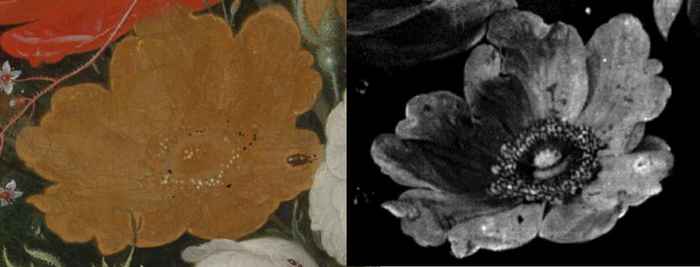Revealing the original brilliance of a faded yellow rose
21 June 2022

The team led by Katrien Keune, head of Science at the Rijksmuseum and professor at the University of Amsterdam’s Van ‘t Hoff Institute for Molecular Sciences, established that in spite of its current vague appearance, Abraham Mignon put great effort in detailing the rose to provide it with brilliance and a nearly three-dimensional appearance. They established that in particular the degradation of the arsenic pigment orpiment and of the yellow lake glaze has each caused substantial optical changes. Light-induced fading of the organic yellow dyestuff in the glaze has caused the intended shadow areas to turn white. In the course of centuries, the yellow bright pigment orpiment underwent several chemical reactions, leading to the precipitation of lead arsenates schultenite and mimetite and the formation of arsenolite. As a result, the once bright yellow paint transformed into a colorless, transparent, and brittle layer. The chemical reactions have irreversibly changed the artists’ intention, but chemical imaging such as MA-XRF scanning made it still possible to recapture the once visible and meticulously applied highlights and shadows of the flower.
Abstract of the paper
Over time, artist pigments are prone to degradation, which can decrease the readability of the artwork or notably change the artist’s intention. In this article, the visual implication of secondary degradation products in a degraded yellow rose in a still life painting by A. Mignon is discussed as a case study. A multimodal combination of chemical and optical imaging techniques, including noninvasive macroscopic x-ray powder diffraction (MA-XRPD) and macroscopic x-ray fluorescence imaging, allowed us to gain a 3D understanding of the transformation of the original intended appearance of the rose into its current degraded state. MA-XRPD enabled us to precisely correlate in situ formed products with what is optically visible on the surface and demonstrated that the precipitated lead arsenates and arsenolite from the yellow pigment orpiment and the light-induced fading of an organic yellow lake irreversibly changed the artist’s intentional light-shadow modeling.
Paper details
Nouchka De Keyser, Fréderique Broers, Frederik Vanmeert, Steven De Meyer, Francesca Gabrieli, Erma Hermens, Geert Van der Snickt, Koen Janssens, Katrien Keune: Reviving degraded colors of yellow flowers in 17th century still life paintings with macro- and microscale chemical imaging. Sci. Adv. 8, eabn6344 (2022) 8 June 2022. DOI: 10.1126/sciadv.abn6344